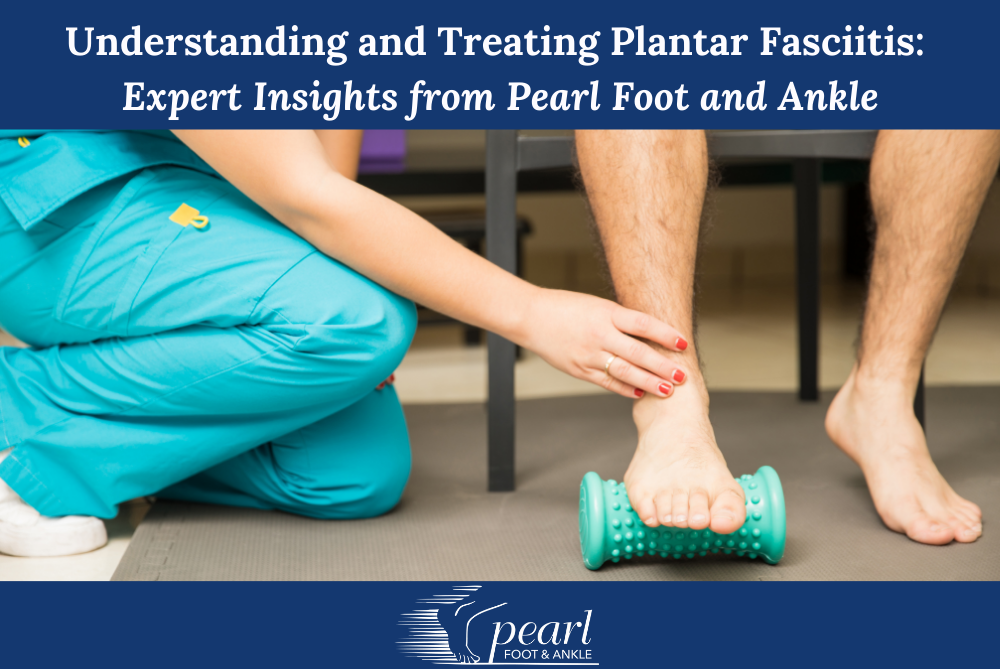 Plantar fasciitis is one of the most common causes of heel pain, affecting millions of people worldwide. Whether you’re an athlete, a professional on your feet all day, or someone who enjoys casual walks, this condition can significantly impact your quality of life. At Pearl Foot and Ankle, we specialize in diagnosing and treating plantar fasciitis with effective, patient-centered care.
Plantar fasciitis is one of the most common causes of heel pain, affecting millions of people worldwide. Whether you’re an athlete, a professional on your feet all day, or someone who enjoys casual walks, this condition can significantly impact your quality of life. At Pearl Foot and Ankle, we specialize in diagnosing and treating plantar fasciitis with effective, patient-centered care.
What is Plantar Fasciitis?
Plantar fasciitis occurs when the plantar fascia—a thick band of tissue that runs along the bottom of your foot, connecting the heel bone to the toes—becomes inflamed. This inflammation is often caused by excessive strain, leading to heel pain and stiffness, particularly in the morning or after prolonged periods of rest.
Causes and Risk Factors
Plantar fasciitis is typically caused by:
- Overuse or repetitive stress – Common in runners, dancers, and those who stand for long periods.
- Improper footwear – Shoes lacking proper arch support or cushioning can contribute to strain.
- Foot mechanics – Flat feet, high arches, or abnormal walking patterns can increase stress on the plantar fascia.
- Weight gain – Excess weight puts additional pressure on the feet.
- Tight calf muscles or Achilles tendons – Reduced flexibility can alter foot mechanics, leading to plantar fasciitis.
Symptoms of Plantar Fasciitis
- Sharp or stabbing heel pain, especially with the first steps in the morning.
- Pain after prolonged sitting or standing.
- Increased discomfort post-exercise (though not usually during activity itself).
- Tenderness in the bottom of the foot near the heel.
Diagnosis
At Pearl Foot and Ankle, our specialists diagnose plantar fasciitis through:
- Medical history review – Discussing your symptoms and lifestyle habits.
- Physical examination – Identifying pain points and assessing foot mechanics.
- Imaging tests (if necessary) – X-rays or ultrasounds to rule out other conditions like fractures or heel spurs.
Treatment Options
Our treatment approach focuses on pain relief, inflammation reduction, and preventing recurrence. Options include:
Conservative Treatments
- Rest and Activity Modification – Reducing activities that exacerbate the condition.
- Ice Therapy – Applying ice packs to reduce inflammation.
- Stretching and Strengthening Exercises – Targeting the plantar fascia and calf muscles to enhance flexibility and support.
- Orthotics and Footwear Adjustments – Custom orthotics or supportive shoes help distribute pressure evenly.
- Night Splints – Wearing a splint can keep the foot in a stretched position overnight, reducing morning pain.
Advanced Treatments
If conservative methods don’t provide relief, we may recommend:
- Corticosteroid Injections – To reduce severe inflammation and pain.
- Shockwave Therapy (ESWT) – A non-invasive treatment that stimulates healing.
- Platelet-Rich Plasma (PRP) Therapy – Uses your body’s natural healing factors to promote tissue repair.
- Surgery (as a last resort) – In rare cases, surgical intervention may be necessary to release the plantar fascia.
Q&A: Common Questions About Plantar Fasciitis
Q: How long does it take to recover from plantar fasciitis?
A: Most people experience relief within a few months with proper treatment, but some cases may take up to a year to fully resolve.
Q: Can plantar fasciitis go away on its own?
A: While mild cases may improve over time, professional treatment can significantly speed up recovery and prevent worsening.
Q: What are the best shoes for plantar fasciitis?
A: Supportive shoes with good arch support, cushioning, and a slightly raised heel are best. Avoid flat shoes and flip-flops.
Q: Can I still exercise with plantar fasciitis?
A: Low-impact activities like swimming, cycling, and yoga are better alternatives until symptoms improve.
Q: When should I see a doctor for plantar fasciitis?
A: If your heel pain lasts longer than two weeks despite home treatment, or if the pain is severe and impacts daily activities, it’s time to consult a specialist.
Why Choose Pearl Foot and Ankle for Your Foot Health?
At Pearl Foot and Ankle, our experienced podiatrists provide personalized treatment plans to help you walk pain-free again. Whether you’re experiencing mild discomfort or severe pain, we have the expertise and advanced treatment options to address your needs.
Contact Information
📍 Portland Office
1827 NE 44th Ave, Suite 100, Portland, OR 97213
📞 (503) 284-2000 | 📠 (503) 284-2002
📍 Gresham Office
2850 SE Powell Valley Rd, Suite 104, Gresham, OR 97080
📞 (503) 284-2000 | 📠 (503) 676-6152
📍 Beaverton Office
12672 NW Barnes Rd, #100, Portland, OR 97229
📞 (503) 284-2000 | 📠 (971) 228-8377
If you’re struggling with heel pain, don’t wait—schedule an appointment with Pearl Foot and Ankle today and take the first step toward lasting relief!
